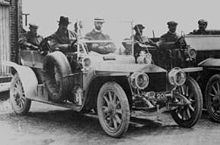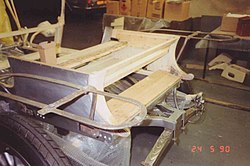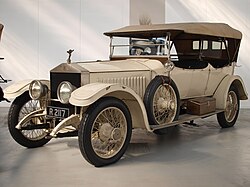auto.wikisort.org - Automobile
The Rolls-Royce Silver Ghost name refers both to a car model and one specific car from that series.
| Rolls-Royce 40/50 Silver Ghost | |
|---|---|
 AX201, Roi-des-Belges tourer by Barker | |
| Overview | |
| Manufacturer | Rolls-Royce Ltd (UK) Rolls-Royce of America (US) |
| Also called | 40/50 |
| Production | 1906–1926 7874 made[1] |
| Assembly | Derby, England Springfield, Massachusetts[2] |
| Body and chassis | |
| Class | Luxury car |
| Related | Rolls-Royce armoured car |
| Powertrain | |
| Engine | straight 6 7036cc (429.4cid) (1906–1910) 7428cc (453.3cid) (from 1910) |
| Transmission | 3-speed manual (1909–1913) 4-speed manual (from 1913) |
| Dimensions | |
| Wheelbase | 135.5 in (3,442 mm) (1906—1913) 143.5 in (3,645 mm) (1913—1923) 144 in (3,658 mm) and 150.5 in (3,823 mm) (from 1923) |
| Chronology | |
| Predecessor | Rolls-Royce 30 hp |
| Successor | Phantom I |



7,428cc side-valve six-cylinder engine.
Originally named the "40/50 h.p." the chassis was first made at Royce's Manchester works, with production moving to Derby in July 1908, and also, between 1921 and 1926, in Springfield, Massachusetts. Chassis no. 60551, registered AX 201, was the car that was originally given the name "Silver Ghost." Other 40/50 hp cars were also given names, but the Silver Ghost title was taken up by the press, and soon all 40/50s were called by the name, a fact not officially recognised by Rolls-Royce until 1925, when the Phantom range was launched.
The Silver Ghost was the origin of Rolls-Royce's claim of making the "best car in the world" – a phrase coined not by themselves, but by the prestigious publication Autocar in 1907.[citation needed]
The chassis and engine were also used as the basis of a range of Rolls-Royce Armoured Cars.
History

In 1906, Rolls-Royce produced four chassis to be shown at the Olympia car show, two existing models, a four-cylinder 20 hp and a six-cylinder 30 hp, and two examples of a new car designated the 40/50 hp. The 40/50 hp was so new that the show cars were not fully finished, and examples were not provided to the press for testing until March 1907.[3]
The car at first had a new side-valve, six-cylinder, 7036 cc engine (7428 cc from 1910) with the cylinders cast in two units of three cylinders each as opposed to the triple two-cylinder units on the earlier six. A three-speed transmission was fitted at first with four-speed units used from 1913. The seven-bearing crankshaft had full pressure lubrication, and the centre main bearing was made especially large to remove vibration, essentially splitting the engine into two three-cylinder units. Two spark plugs were fitted to each cylinder with, from 1921, a choice of magneto or coil ignition.[4] The earliest cars had used a trembler coil to produce the spark with a magneto as an optional extra which soon became standard - the instruction was to start the engine on the trembler/battery and then switch to magneto. Continuous development allowed power output to be increased from 48 bhp (36 kW) at 1,250 rpm to 80 bhp (60 kW) at 2,250 rpm. Electric lighting became an option in 1914 and was standardised in 1919.[1] Electric starting was fitted from 1919[4] along with electric lights to replace the older ones that used acetylene or oil.
Development of the Silver Ghost was suspended during World War I, although the chassis and engine were supplied for use in Rolls-Royce Armoured Cars.[5] A blue 1909 Silver Ghost known as Blue Mist, previously owned by an Irish lord, was used by Lawrence of Arabia as his personal staff car during the Arab Revolt.[6][7] Construction of a replica Blue Mist began in 2018.[8]
The chassis had rigid front and rear axles and leaf springs all round. Early cars only had brakes on the rear wheels operated by a hand lever, with a pedal-operated transmission brake acting on the propellor shaft. The footbrake system moved to drums on the rear axle in 1913. Four-wheel servo-assisted brakes became optional in 1923.[4]
Despite these improvements the performance of the Silver Ghost's competitors had improved to the extent that its previous superiority had been eroded by the early 1920s. Sales declined from 742 in 1913 to 430 in 1922. The company decided to launch its replacement which was introduced in 1925 as the New Phantom.[9] After this, older 40/50 models were called Silver Ghosts to avoid confusion.
A total of 7874 Silver Ghost cars were produced from 1907 to 1926, including 1701 from the American Springfield factory. The documented chassis price listed for the 1921 American version was US$11,750 ($178,508 in 2021 dollars [10]).[4][2] Many of them still run today. A fine example is on display at the National Motor Museum, Beaulieu.
The Alpine Eagles
A 40/50 was privately entered in the prestigious 1912 Austrian Alpine Trial by James Radley, but its 3-speed gearbox proved inadequate for the ascent of the Katschberg Pass. A factory team of four cars were prepared for the 1913 event with four-speed gearboxes, and engine power increased from 60 bhp (45 kW) to 75 bhp (56 kW) by an increase in compression ratio and larger carburettor. The team gained six awards including the Archduke Leopold Cup. Replicas of the victorious cars were put into production and sold officially as Continental models, but they were called Alpine Eagles by chief test driver (and later Rolls-Royce Managing Director) Ernest Hives, and this is the name that they have kept.[citation needed]
The Silver Ghost
In 1907 Claude Johnson, commercial and managing director of Rolls-Royce, ordered a car to be used as a demonstrator by the company. With chassis no. 60551 and registered AX 201, it was the 12th 40/50 hp to be made,[3] and was painted in aluminium paint with silver-plated fittings. The car was named the "Silver Ghost" to emphasise its ghost-like quietness, and a plaque bearing this name adorned the bulkhead. An open-top Roi-des-Belges body by coachbuilder Barker was fitted, and the car readied for the Scottish reliability trials of 1907 and, immediately afterwards, another 15,000-mile (24,000 km) test which included driving between London and Glasgow 27 times.
The aim was to raise public awareness of the new company and to show the reliability and quietness of their new car. This was a risky idea: cars of this time were notoriously unreliable, and roads of the day could be horrendous. Nevertheless, the car set off on trials, and with press aboard, broke various records. Even after 7,000 miles (11,000 km), the cost to service the car was a negligible £2 2s 7d (£2.13).[3] The reputation of the 40/50, and Rolls-Royce, was established.
AX201 was sold in 1908 to a private customer, who used it for his annual annual [clarification needed] to Italy, and recovered by the company in 1948. Since then, it has been used as a publicity car and travelled worldwide. In 1991, the car was restored.
In 2005 it was noted to be the world's most valuable car, its insured value was placed at US$35 million.[11]
After the 1998 sale of Rolls-Royce Motors Ltd the car passed into the ownership of Bentley Motors.[3]
- AX 201 in a photo from 1990, prior to restoration
- AX 201 with body & chassis separated
- AX 201 rear end showing ash frame
Gallery
- 1909 landaulet by Hooper, Science Museum, London
- 1910 tourer, National Automobile Museum, Reno
- 1913 Silver Ghost at Stahls Automotive Collection
- 1914 tourer in Museo Nazionale dell'Automobile, Torino
- 1920 chassis 40FW tourer by Labourdette
- A 1922 half-track owned by Vladimir Lenin, at Gorki Leninskiye
See also
References
Notes
- The Rolls-Royce Motor Car. Anthony Bird and Ian Hallows. Batsford Books. 2002 ISBN 0-7134-8749-6
- Kimes, Beverly R. (1996). Clark, Henry A. (ed.). The Standard Catalog of American Cars 1805-1945. Kraus Publications. pp. 1307–1308. ISBN 0873414780.
- Evans, Michael (2004). In the Beginning-the Manchester Origins of Rolls-Royce. Derby, UK: Rolls-Royce Heritage Trust. ISBN 1-872922-27-9.
- Baldwin, N. (1994). A-Z of Cars of the 1920s. Devon, UK: Bay View Books. ISBN 1-870979-53-2.
- Chariots of war
- Well Here We Are
- Cambridge News
- PR Web
- Pugh, Peter (2001). The Magic of a Name - The Rolls-Royce Story: The First 40 Years. Icon Books. ISBN 1-84046-151-9.
- 1634–1699: McCusker, J. J. (1997). How Much Is That in Real Money? A Historical Price Index for Use as a Deflator of Money Values in the Economy of the United States: Addenda et Corrigenda (PDF). American Antiquarian Society. 1700–1799: McCusker, J. J. (1992). How Much Is That in Real Money? A Historical Price Index for Use as a Deflator of Money Values in the Economy of the United States (PDF). American Antiquarian Society. 1800–present: Federal Reserve Bank of Minneapolis. "Consumer Price Index (estimate) 1800–". Retrieved 16 April 2022.
- Schaffels, Brandy; Markus, Frank. "2005 Concours at Cranbrook". Motor Trend. Archived from the original on 18 February 2006.
Bibliography
- Holmes, Mark (2007). Ultimate Convertibles: Roofless Beauty. London: Kandour. pp. 142–147. ISBN 978-1-905741-62-5.
External links
- "Ambassador Extraordinary - A History of 'The Silver Ghost'", reprint from Queste, 1990
- Rolls-Royce and Bentley Models
На других языках
[de] Rolls-Royce Silver Ghost
Der Begriff Rolls-Royce Silver Ghost (dt.: Silberner Geist) bezeichnete ursprünglich ein einzelnes Automobil der Baureihe Rolls-Royce 40/50 hp des britischen Herstellers Rolls-Royce, das mit besonderen Spezifikationen ausgeliefert wurde. Später wurde die Bezeichnung auf die gesamte Baureihe übertragen.- [en] Rolls-Royce Silver Ghost
[fr] Rolls-Royce Silver Ghost
Rolls-Royce Silver Ghost est le nom donné au châssis numéroté AX201 avec une carrosserie en aluminium poli de couleur gris argenté[3] de la Rolls-Royce 40/50 HP qui est le sixième modèle d'automobile conçu par Henri Royce en 1907. Ce n'est qu'en 1925, lorsque Rolls Royce lance le modèle new Phantom que le nom de Silver Ghost est officiellement donné à toute la série des 40/50 HP. Sur les 7874 Silver Ghost qui ont été produites entre 1907 et 1926 il en reste environ 1500[4].[it] Rolls-Royce Silver Ghost
La Silver Ghost, in origine chiamata 40/50 hp, è un'autovettura prodotta dalla Rolls-Royce dal 1907 al 1926. La denominazione si riferisce sia ad un esemplare preciso che ad una serie di automobili.[ru] Rolls-Royce Silver Ghost
Rolls-Royce 40/50HP Silver Ghost — автомобиль премиум-класса, разработанный и выпускавшийся британской компанией Rolls-Royce. Разрабатывавшийся в 1905—1906 годах и впервые представленный публике в марте 1907-го, Rolls-Royce 40/50HP выпускался вплоть до 1926 года. Общий выпуск составил 7874 единиц. Широко известное имя Silver Ghost (в переводе с англ. — «Серебряный призрак») изначально являлось именем собственным автомобиля с номером шасси 60551, однако вскоре распространилось на всю серию как таковую. «Серебряный Призрак» был одним из первых автомобилей компании Rolls-Royce. Rolls-Royce 40/50HP Silver Ghost также послужил базой для бронеавтомобиля Rolls-Royce Armoured Car.Другой контент может иметь иную лицензию. Перед использованием материалов сайта WikiSort.org внимательно изучите правила лицензирования конкретных элементов наполнения сайта.
WikiSort.org - проект по пересортировке и дополнению контента Википедии








